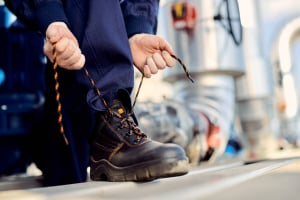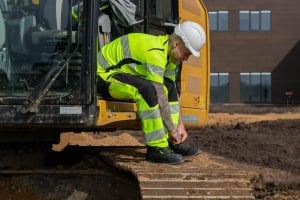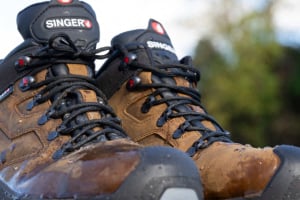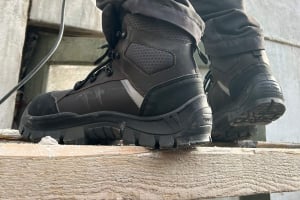
What are the best safety shoes for women?
The importance of appropriate personal protective equipment, particularly safety footwear for women operating in demanding environments, is well recognized. This article aims to guide through the essential criteria for choosing the best safety shoes, specifically meeting the needs of women in the field.
Summary
Importance of safety shoes for women
Workplace accidents spare no one, and the feet are among the parts of the body most exposed to injury. Statistics show that many incidents could be avoided by wearing the right safety shoes, highlighting their importance fundamental. Indeed, a foot injury can not only lead to prolonged absence from work, but also have long-term consequences on mobility and quality of life.
It is essential to recognize that women's safety shoes are not a simple replica of those of men. They are designed taking into account the specific morphology of the female foot, thus offering better comfort and optimal protection. This distinction is crucial, because wearing unsuitable shoes can not only compromise personal safety but also lead to pain and foot deformities in the long term.
Furthermore, in many industrial and construction sectors, risks vary widely, from falling heavy objects and puncture hazards to slippery surfaces and electrical hazards. Women's safety shoes are specially designed to meet these diverse challenges, incorporating durable materials and advanced technologies for increased protection against these specific risks.
Criteria for choosing safety shoes for women
Comfort is essential, as poorly fitting shoes can not only cause discomfort but also long-term injury. To avoid this, it is essential to choose shoes that fit well to the shape of your feet. This means taking into account the width of the foot, the arch and even the volume of the foot to ensure that the shoe supports the foot properly without restricting circulation or creating painful pressure points.
In addition, footwear must meet strict safety standards and have appropriate certifications to ensure effective protection against the specific risks of your work environment. Standards vary by country and industry, but they generally cover impact resistance, compression, puncture, and sometimes even protection against electrical and chemical hazards. Looking for shoes certified according to these standards is a guarantee of their reliability and effectiveness in terms of protection.
Selecting high-quality materials is also crucial to ensure your shoes last in harsh working conditions, while still providing adequate protection. Materials such as premium leather, wear-resistant rubber and advanced composites for the toe caps and midsoles provide an excellent balance between durability and comfort. Modern technologies have also made it possible to develop lightweight materials that do not sacrifice protection, thereby reducing foot fatigue during a long work day.
Lightweight safety shoes for women
lightweight safety shoes reduce foot fatigue and improve everyday comfort, a particularly important aspect for women who spend long hours on their feet. By minimizing the weight each foot must support, these shoes help prevent pain and discomfort that can occur after a long day of work. This increased comfort can not only improve overall well-being, but also increase productivity and concentration at work.
Modern technology has played a key role in the development of lightweight safety footwear without compromising their ability to protect against hazards. Innovative materials, such as composites for the protective toe caps and breathable mesh materials for the shoe body, provide excellent protection while significantly reducing weight. These materials also guarantee good air circulation, which helps regulate foot temperature and reduce perspiration, for even greater comfort.
It is also important to note that shoes lightweight safety shoes for women don't sacrifice functionality for lightness. They are equipped with essential safety features such as slip resistance, protection against electric shock and puncture resistance. This makes them suitable for a variety of work environments, from construction sites to laboratories, factories and warehouses.
Specific characteristics of safety shoes for women
Women's safety shoes incorporate advanced foot support technologies, which play a role in preventing work-related pain and injuries. Ergonomic insoles, for example, are designed to adapt to the unique shape of the foot, providing support where it is needed most. They help distribute weight evenly across the foot, reducing pressure on sensitive points like the heel and forefoot. Additionally, innovative suspension systems absorb shock and reduce the impact of walking on hard surfaces, decreasing the risk of joint pain and muscle fatigue.
At the same time, the use of breathable materials in the manufacturing of women's safety shoes is another essential feature that contributes to increased comfort. These materials allow efficient air circulation inside the shoe, helping to regulate foot temperature and reduce sweating. This control of the internal microclimate is vital to avoid excessive humidity, which can lead to discomfort and skin problems such as fungus and irritation. By keeping feet dry and at a comfortable temperature, women's safety shoes provide optimal protection and comfort, even during long working days.
Tips for caring for women's safety shoes
Regular maintenance, such as cleaning and waterproofing, can significantly extend the life of your shoes and maintain their protective effectiveness. Safety shoes, especially those used in harsh environments, are exposed to many elements that can accelerate their wear, such as dust, humidity, chemicals, and abrasion. Proper care not only helps keep shoes clean and presentable, but also preserves the integrity of materials and safety features.
Regular cleaning after each use is essential to remove dirt and debris that can build up on the shoe and in the soles. Using a soft brush or damp cloth to clean the outer surface and a sponge or cloth for the inside can help keep the shoes in good condition. For more stubborn stains, cleaning products specific to the materials of your shoes can be used.
It is important to replace your shoes when signs of wear become evident or when their comfort and protection capacity diminishes. Signs of wear include, but are not limited to, sole abrasion, deterioration of upper materials, or damage to toe caps. A damaged safety shoe may not provide the necessary protection against the risk of injury, putting the user at risk. Additionally, an uncomfortable or poorly fitting shoe can cause foot pain and contribute to posture problems and fatigue. It is therefore important to regularly inspect your safety shoes and replace them as necessary to ensure optimal protection and continued comfort.
We encourage users to invest in quality safety shoes, adapted to their professional and personal specificities, to not only stay safe but also feel good in their shoes, whatever the conditions. the challenges they encounter on a daily basis. Protecting yourself with the right equipment is the first step towards a successful and fulfilling career in any demanding work environment.






